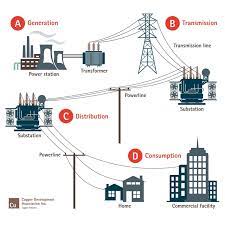In this episode - The Electric Grid . . .
Flip a switch, and a light comes on. In most cases, the electricity to power that device came from an enormous interconnected system called the electric grid. Have you ever wondered how it works?
What is the Electric Grid?
An electric grid is a network of synchronized power providers and consumers connected by transmission and distribution lines and operated by one or more control centers. When most people talk about the power "grid," they're referring to the transmission system for electricity.
The continental United States does not have a national grid. Instead, there are three grids: the Eastern Interconnect, the Western Interconnect, and the Texas Interconnect. In Alaska and Hawaii, several smaller systems interconnect parts of each state.
Electricity gets generated in many different ways: Power plants that burn oil, gas, or coal. Nuclear plants. Solar arrays. Wind farms and hydroelectric Dams where water cascades. In most places, the grid connects hundreds or more of these places to a vast network of wires and equipment. Electric current can travel along many paths within this network. Power also can flow either way along the cables. Equipment directs the current where needed.
Two-way wires allow the use of alternating current or AC. Electric grids in most countries use AC current. AC means the current switches direction many times per second. With AC, transformers can boost the voltage or force of the current. High voltage is more efficient for sending electricity over long distances through wires. Transformers then step the voltage down to lower, safer levels before the current travels onto your home or business.
How does this affect you?
Unless you live "off-the-grid" (in a remote cabin in the mountains), you take electricity for granted every day in many ways; your coffee pot, refrigerator, heating, air-conditioning, lighting, television, charging your phone, and so much more. Speaking of television, I'm sure you've seen commercials touting that you can eliminate your electric bill by going Solar. I'm sorry that's not possible. Why? Because your Solar system is connected to the grid.
The utility company that provides you with power has charges on your bill called "Non-bypassable" charges.
Non-bypassable charges are fees you pay for every kilowatt-hour of electricity you consume from the grid. These charges can fund energy assistance programs for low-income households and energy efficiency programs. These charges apply even if you buy your grid-supplied power from an outside power company.
According to Chris Pilong, an electrical engineer at PJM Interconnection in Audubon, Penn. There's a catch. "We need to keep things perfectly balanced." PJM runs the grid for all or parts of 13 states, plus the District of Columbia.
By balanced, Pilong means that the amount of electricity supplied at any time must match the amount used. Too much power can overheat wires or damage equipment. Too little power can lead to problems such as blackouts and brownouts. Blackouts are losses of all power to some regions. Brownouts are partial drops in the system's ability to supply power.
Why must I be connected?
I can hear you saying, "But wait just one minute, I get credit for the excess power we generate on our bill. What if I just disconnect from the grid?"
Ok, but what happens at night. How do you run your appliances and lights? The typical answer these days is battery storage. Sounds easy, but have you ever looked into what's required to use battery storage to be independent of the grid?
That's an entirely different subject. We will explore battery storage in another episode.
I'm Patrick Ball; thanks for listening. I'll see you in the next episode.
References:
https://freedomforever.com/blog/non-bypassable-charges/
https://www.sciencenewsforstudents.org/article/explainer-what-electric-grid

Comments